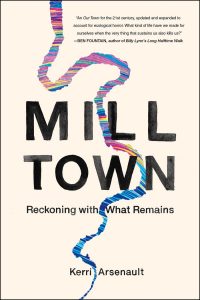Mill Town: Reckoning with What Remains
 Mill Town: Reckoning with What Remains, by Kerri Arsenault (New York, NY: St. Martin’s Press, 2020)
Mill Town: Reckoning with What Remains, by Kerri Arsenault (New York, NY: St. Martin’s Press, 2020)In “Mill Town: Reckoning with What Remains,” author Kerri Arsenault melds the legacy of unregulated corporate exploitation and the history of her Acadian ancestors’ expulsion from Canada into a devastating indictment of the environmental pollution that impacted her hometown and its workers – including her own family.
Arsenault’s book is set in the small, neighboring paper mill towns of Rumford and Mexico in Maine’s Androscoggin River valley. There, during her childhood, billowing smokestacks pierced the pristine sky near the primeval North Maine Woods, and a mysterious rotten smell rose from the polluted river – memories that lingered when she returned to Mexico to research her family.
Arsenault set out to learn more about her grandfather William after discovering in his obituary that he was born in Prince Edward Island, worked in a paper mill bleach room, and died of cancer soon after his retirement.
The bigger story
But as she queried residents about her genealogy and local history, they shared a bigger story – reports of elevated cancer rates in valley mill towns and downstream fish with high concentrations of dioxin, a byproduct of paper bleaching and the burning of mill sludge waste. Dioxin is a persistent, toxic, cancer-causing pollutant – the same chemical found at Love Canal and in the Agent Orange defoliant used in Vietnam. Arsenault realized this was part of her family’s story, too.
In chapters that unfold like linked essays, Arsenault alternately writes about her ancestral quest and the deadly environmental pollution that propelled her hometown’s residents and the paper mill workers into action against International Paper, Oxford Paper Company, Boise Cascade and a succession of millowners.
A sordid history of pollution
Arsenault chronicles the mill’s founding in the 1800s by Hugh J. Chisholm – a railroad news distributor-turned-lithographer. Where writer and naturalist Henry David Thoreau and others admired the bucolic beauty of Maine’s woods and waterfalls, Chisholm saw only profit – buying up acres of Rumford, Maine property.
“By 1898, Chisholm and his partner William Augustus Russell combined seventeen pulp and paper companies, including the Rumford mill, to establish International Paper,” writes Arsenault, “then and today the biggest paper company in the world.” The Rumford area was built up in the process, and her Acadian great-grandfathers arrived there to work in the mill.
The factories chugged along unregulated – polluting air, land and water – until nauseating, eye-stinging river gasses prompted Maine’s attorney general to sue the paper giants in 1942, forcing them to reduce their discharge. Yet in 1952, when Arsenault’s father was hired as a mill pipefitter, production of catalogs, books, stationery and glossy magazines that used bleached, coated paper stock had undercut earlier environmental controls. A 1958 contract to print National Geographic magazine didn’t help.
“The windfall, while providing steady work for the town, also brought with it a windfall of pollution that exacerbated the toxic load,” writes Arsenault – toxins that took a toll on the health of mill workers, their families and their neighbors.
Fightback efforts
Faced with confronting a giant employer they depended on for jobs in a working-class company town, the Rumford-Mexico community and workers nevertheless made attempts to rein in the polluting bosses. Their valiant efforts are detailed in “Mill Town.”
A doctor spoke up about elevated cancer rates among local patients and endured career-jeopardizing pushback from Maine agencies and a local hospital. He and town residents appeared in a 1991 documentary “Cancer Valley,” which publicized the cancer spike and exposed the company’s release of contaminated water into the town’s drinking water supply.
Residents attended public hearings. Local stakeholders joined an EPA-sponsored study group, which found Rumford cancer rates were significantly elevated compared to the rest of Maine. Toxic Waste Women was organized to do independent air sampling.
Workplace exposures
The paper mill workers’ union asked the National Institute for Occupational Safety and Health (NIOSH) to test whether workers’ blood levels of toxins exceeded levels in the local community. NIOSH found the blood levels were comparable.
“But to me, residents and employees getting doses of the toxics didn’t vindicate anything,” Arsenault writes. “It established cause for concern that everyone was susceptible to the pollution’s reach.”
United Steelworkers Local 900 tapped a paper mill hourly-wage worker to serve as a shop-floor safety advocate and liaison. However, the workers faced an uphill struggle against a mega-corporation that in 1989 had amassed 531 alleged federal work safety violations at the Rumford mill – about 300 of them deemed “egregious” by OSHA. Then-owner Boise Cascade was fined $1.5 million, one of OSHA’s largest penalties ever.
A cautionary tale
Other companies appear briefly. When the Nestlé corporation sought to source its Poland Spring bottled water from Rumford’s drinking water supply, Arsenault joined her hometown’s residents to protest the move.
Arsenault also discusses the paternalistic owner of Burt’s Bees, who angered Maine residents by purchasing swaths of the North Maine Woods for a possible national park without consulting local communities – a sentiment she once shared but thought better of as more and more wilderness was preserved.
However, the overriding thrust of “Mill Town” is the devastating legacy of corporate environmental pollution that remains in two once-vibrant Maine factory towns – a cautionary tale in our era of climate change and more frequent environmental emergencies.
Reviewed by Molly Charboneau, a member of the National Writers Union and an award-winning website content editor for the Retirees Association of DC 37 AFSCME. www.dc37retireesassociation.org
